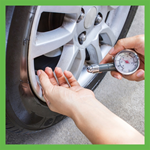Why Does My Tire Pressure Light Only Come On in the Morning?

Remember wondering why you had to learn about solids, liquids and gases in science class? Well, here is one application!
The air in your tires is, in fact, a gas which means it expands and condenses based on it’s temperature. Since a tire traps air in an enclosed space, any expansion of the air will increase the tire pressure while any condensation of the air will decrease the tire pressure.
Tire pressure, measured in pounds per square inch (PSI), can fluctuate by 1 PSI for every 10 degrees in temperature change.
In Connecticut, the average temperature in June can fluctuate 15-30 degrees in one day which means your tire pressure can fluctuate 1-3 PSI.
Most car manufacturers set the tire pressure monitoring system (TPMS) to trigger your dash light to come one when your tire is approximately 25% below the expected PSI.
Let’s assume you drive a Toyota RAV4 with a recommended tire pressure of 33 PSI. Since the tire pressure warning light will come on when the tire pressure is 25% less than the recommendation, you can expect to see the icon light up on your dashboard when the pressure falls below 25 PSI.
Say you wake up on a brisk 60-degree morning and you notice your tire pressure light is on, but when you go to lunch that sunny 80-degree afternoon the light is no longer on. You may wonder, is my sensor faulty? But a much more likely explanation is that your tire pressure was 24 PSI that cold morning and increased to 26 PSI by the afternoon because the temperature increased by 20 degrees. Since 26 PSI is only 21% less than the manufacturer recommendation, the warning light will no longer be triggered. However, your tire is still 7 PSI below the ideal pressure!
Long story short, even if your tire pressure warning light is only activated some of the time, your tire pressure is below the manufacturer recommendation ALL of the time!

